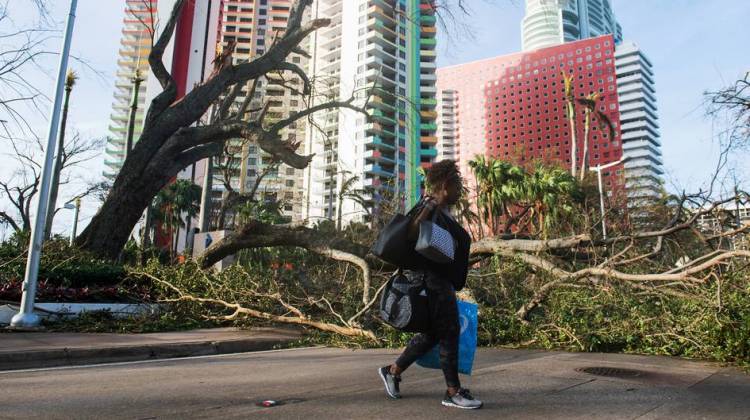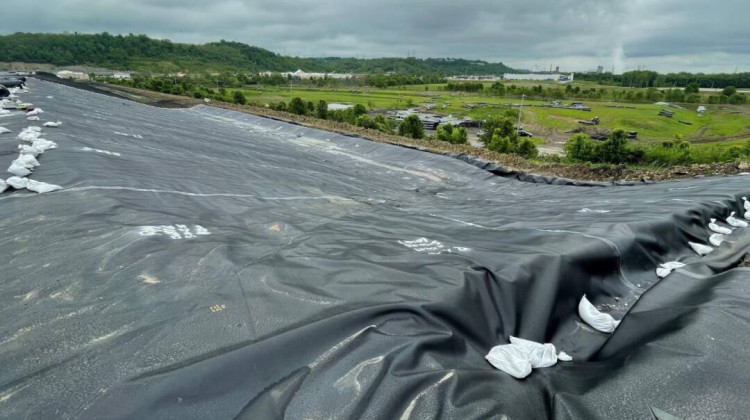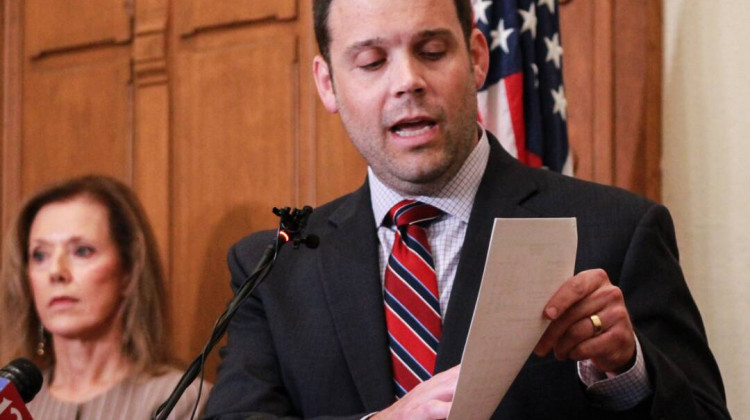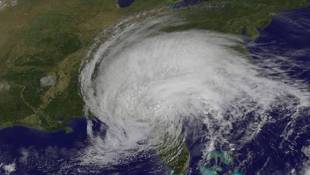
Estrella Palacios walks through debris caused by Hurricane Irma in Miami. While the full extent of Irma's damage isn't yet known, the storm has weakened at a faster rate than expected.
Saul Loeb/AFP/Getty ImagesUpdated at 2 p.m. ET
In Florida, Hurricane Irma has brought dangerous floodwaters, knocked out power to millions and turned human possessions into debris in the past 24 hours. After making landfall on Sunday, the huge storm remained a Category 1 hurricane as it moved over the state's northwest early Monday, before finally being downgraded to a tropical storm.
Irma has maximum sustained winds of 60 mph, with stronger gusts. At 2 p.m. ET, Irma's center was about 50 miles south-southeast of Albany, Ga., and 55 miles east of Tallahassee.
Flash flood warnings have been issued in Jacksonville — a victim, like other eastern Florida areas, of the heaviest rains that are commonly found in hurricanes' northeast quarter. Flood and tornado warnings have been issued for parts of coastal Georgia and South Carolina.
More than 6 million electricity accounts in Florida are currently without power, state officials say. While the full extent of Irma's damage isn't yet known, the storm has weakened at a faster rate than expected.
As the sun rose Monday, many Floridians anxiously began to assess the damage wrought by the hurricane, either inspecting their houses and neighborhoods for themselves or contacting those who stayed behind.
For those caught in Irma's path — and wondering what to do after it passes — member station WLRN in Miami has assembled a guide to help.
Irma was a hurricane for part of 12 days, having been dubbed a hurricane on Aug. 31, when it was far from land in the Atlantic Ocean. For days, it was a Category 5 storm, wreaking havoc in the Caribbean, where recovery efforts are still underway.
On Monday morning, the storm brought storm surge risks as high as 4 to 6 feet above normal water levels in parts of Florida. Irma was also extending tropical-storm-force winds outward up 415 miles, the National Hurricane Center says.
The perilous storm and the massive evacuation it sparked were reflected in an unusual scene in Florida early Monday, when the state's skies were empty of airliners. A screenshot taken by journalist Sam Sweeney shows, as he wrote, "not a single airplane over the state of Florida."
Irma is moving north-northwest at nearly 17 mph — a motion that's expected to continue through Tuesday. The storm's center is forecast to move near the Florida Peninsula's northwestern coast and cross the eastern Florida Panhandle into southern Georgia Monday afternoon. It will then move through southwestern Georgia and eastern Alabama through the night and into Tuesday.
Hurricane Jose, which had shadowed part of Irma's route toward the Leeward Islands, has veered off north, as expected — but forecasters say the storm will follow an odd curlicue path over the next several days, putting it south of its current position and possibly threatening parts of the Bahamas this weekend.
When it arrived in Florida, Irma was more than 400 miles wide; the storm remains huge. Consider that when it made landfall at the bottom of Florida's peninsula on Sunday, Irma's thick bands of rain were already drenching parts of northern Florida and southern Georgia.
Hurricane Irma made landfall twice in Florida on Sunday, smacking into the Florida Keys as a Category 4 storm before moving over water and hitting Marco Island as a Category 3 on Florida's southwest coast.
Here are some of the stories we're seeing in Florida:
Jacksonville
The city has already seen bad flooding, as the St. Johns River overflowed its banks — and it's going to get worse around 2 p.m., when high tide will come, the Jacksonville Sheriff's Office says.
The sheriff's office writes Monday morning: "Historic flood levels already. Levels will continue to rise. Expect 4-6 feet above normal high tide levels. You need to be concerned."
Officials had been calling for people to leave areas along the St. Johns River, and to contact emergency numbers for help leaving. To those who didn't leave, the sheriff's office says, "If you can't get out, you need to get to a house with a second story."
Key West
The far-flung island lost power and phone connections, but some news began to emerge from Key West late Sunday night. Photographer Rob O'Neal relayed an account of damage, highlighted by flooding, and downed trees and utility poles. Some buildings had also lost their rooftops.
"Counted 10-20 utility lines & 20 trees down in Oldtown. Downed trees & tree limbs scattered throughout KW. Counted at least 100 ppl walking around outside after eye wall passed," O'Neal said.
"Heaviest damage from Marathon to Lower Keys," O'Neal said.
Thousands of people are believed to have resisted mandatory evacuation orders to stay in the Keys. Sunday night, Monroe County Sheriff Rick Ramsay ordered a dusk-to-dawn curfew for the Keys.
Online
People in the hurricane's path are using a Facebook group to check in and mark themselves as safe, with nearly 400,000 people in the group as of Monday morning, offering peace of mind to loved ones and giving a hint at this storm's reach.
Members of the group also used it to commiserate, share tips and vent their feelings about Irma.
As the sun rose Monday, they also shared some of what they're seeing. A sample, from Davenport, in central Florida, where Benjamin McKinney wrote:
"Walked around to check out my yard. The neighbor's screen patio was torn off and is laying in the street. The stop sign on the corner is missing. The neighbor behind us fence is down. We're missing some pieces from our roof overhang. Our boughanvilla bush was uprooted and pulled our fence out. Nothing too crazy."
Tampa
As the storm approached, it sucked water out of Tampa Bay and other areas, prompting curious residents to head out onto the muddy ground — and, in at least one case, to rescue stranded manatees.
The hurricane center warned on Sunday, "Don't be fooled by low water conditions on the FL W coast ahead of Irma, water will rapidly surge back when the winds change direction."
Around midday on Monday, the National Weather Service office in Tampa extended flood warnings for at least 10 rivers, saying they're close to flood levels — and will rise further.
"Significant river flooding will continue over the next several days as heavy rainfall from Hurricane Irma drains into West Central Florida rivers," the agency says.
Orlando
From member station WMFE:
"Florida Highway Patrol said they're seeing too many people out 'sightseeing' and not obeying the curfew. FHP reports trees are down and there's standing water from the exit ramps at 528 to 520. Those ramps have been closed in both directions...
"FHP says traffic's starting to build up on 95 and the Turnpike southbound. They expect traffic to pick up as the day goes on and people want to go home and check out their property. Officials say people can't enter the Keys, so evacuees need to stay put."
Miami
The city is focusing on clearing roads of debris trees, and sand — in some areas, parts of the beach have been pushed over roadways. Mayor Tomás Regalado said 72 percent of the city of Miami is currently without power, NPR's Hansi Lo Wang reports. Police report at least 26 looting incidents, with 13 arrests made.
"At one time, Miami was dead in the center of the track, and could have been hit very hard," NPR's Jon Hamilton says on Morning Edition. But today, Jon says, much of the city looks "surprisingly normal" — at least out toward the airport.
"I have seen a whole lot of power trucks going by on the freeway out here," Jon adds. "There's still water on the ground in places, they're picking up lots of palm fronds, but the city looks like it's getting back in business."
Miami International Airport saw wind gusts near 100 mph and "sustained significant water damage throughout," the airport director, Emilio Gonzalez, said via Twitter. The facility is closed to passenger flights at least through Monday.
9(MDEwMDc1MzM3MDEzNDczOTA0MDc1MzViMQ001))
 DONATE
DONATE








 View More Articles
View More Articles


 Support WFYI. We can't do it without you.
Support WFYI. We can't do it without you.